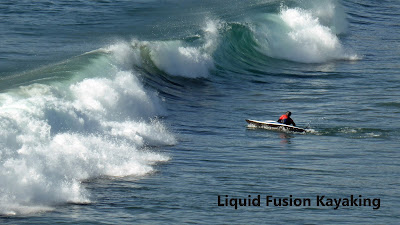For this post in my surf kayaking series, I have surf guru Jeff Laxier sharing his tips for Paddling Out. Jeff has a lifetime of playing in the surf and is a sea, whitewater, and surf kayak instructor for
Liquid Fusion Kayaking.
 |
| Jeff Laxier surfing on the Oregon Coast. |
Paddle Out Techniques by Jeff Laxier
There are many ways to get out to
the waves and here we will explore the three methods I use most to paddle out: Bunny Hop, Turtle Dive, Route Finding.
All three methods have four of
the same components.
1. Speed - We need to be moving to get through a wave.
2. Angle - Boat angle to the incoming wave.
3. Timing - When to paddle hard, when to hold position, and when to run away.
4. Awareness - Of route, waves, other users, wildlife, wonder
The Bunny Hop: This is a fun way
to blast up and over a foam pile (this can also work on river hydraulics).
1. Generate
speed with 3-5 strokes as you approach the foam pile.
2. Change the boat angle to angle away from the wave (No more than 45 degrees)
3. Lift
wave side edge (drop shore-side edge)
4. Forward
sweep on shore-side
5. Once
over the foam pile, lunge forward and paddle, repeat when necessary
 |
| Bunny Hop - Generate Speed. |
 |
| Bunny Hop - Angle/Edge Boat |
 |
| Bunny Hop - Lunge forward and paddle away. |
The Turtle Dive: This is a great way
to avoid a dumping wave on your head, getting hit in the gut by a powerful wave
or foam pile, and decreases the likelihood of the wave pushing you back to shore.
1. Speed - Generate as much speed as possible (don’t get winded you will need that air)
2. Flip - Capsize with precision so your bow will bury into the seam where white and
green water meet then push up with your paddle (this brings the bow deeper).
3. Pause
(feel the wave go by)
Route Finding: Look for an easy path out to the line up with the possibility of a dry hair
paddle out.
1. Find
a rip that will take you out to the outside.
2. Establish
reference points. These will help you make route changes as well and help you avoid the most severe sections. This can also help in reading your progress.
3. Find
the soft spots - Smaller or less consistent waves breaking (path of least
resistance).
4. Wait
for your window of opportunity (wait for a lull).
5. Be
patient and aware.
 |
| Route finding - find a rip and ride it to the outside. |
 |
| Route finding - find the soft spot of the wave or where it isn't breaking. |
Conclusion:
Surfing waves is great fun, and
getting out past the breakers is necessary in all types of craft. Whatever your
craft (surf kayak, whitewater kayak, sea kayak, surfboard, stand up
paddleboard), we have to paddle out. A seasoned paddler will make this
journey out to the lineup easy, effective and efficient and have more energy for surfing. We must plan and
prepare both mentally and physically. The more challenging the paddle out the
more physical and mental toughness is needed.







-L.jpg)




















